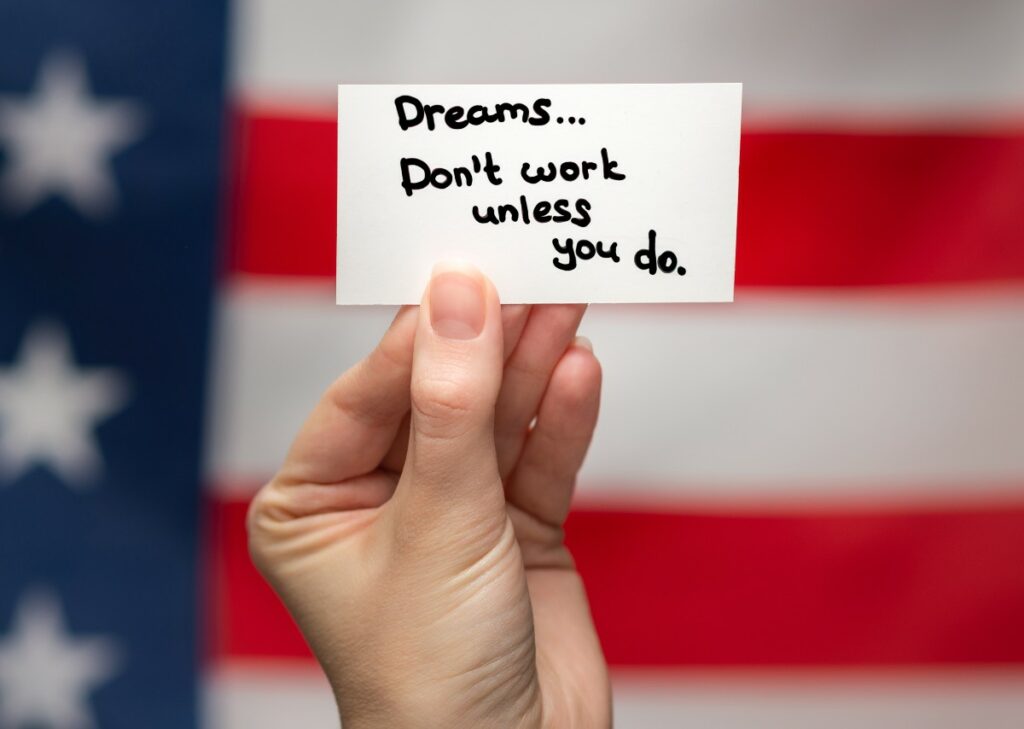This post originally appeared at https://www.badgerinstitute.org/what-americans-believe-about-the-american-dream/
And some Wisconsinites who overcame adversity to achieve it
Wisconsin’s kids are starting to return to classrooms, and I’ve been thinking about what a longtime school reformer told me a while back about the biggest challenge for the ones from poor neighborhoods.

Struggles with math and reading? Not enough teachers? Too many disruptive classmates? Unstable home lives?
Nope.
She said the biggest challenge is getting kids to believe they have “agency” — convincing them, in other words, that their efforts matter, that they can lift themselves up the way others before them have, that there is hope rather than systemic oppression.
Most Americans still believe that.
A survey a few months ago that the Archbridge Institute did with the University of Chicago found that 75% of Americans — regardless of age, race, income or education — believe they have either achieved the American Dream or are on the way to achieving it.
That’s not to say opportunity expands unabated — especially if you narrowly define the American Dream as a chance at economic success no matter one’s background.
Research “shows that children’s chances of earning more than their parents have been declining. Ninety percent of children born in 1940 grew up to earn more than their parents. Today, only half of all children earn more than their parents did,” according to Harvard’s Opportunity Insights program.
Part of the reason, no doubt, is that the post World War II economic boom and its astronomical growth had to slow eventually. At any rate, defining the American Dream solely in economic terms is misleading. Most Americans have a much broader definition.
According to a Pew Research Center analysis from 2017, just 11% said “being wealthy” is essential to the American Dream. Large majorities cite “freedom of choice in how to live” (77%), having a good family life (70%) and retiring comfortably (60%). Over 40% also say making valuable community contributions, owning a home and having a successful career are essential to their view of the American Dream.
Most told Pew back then that they think the American Dream, as they define it, is attainable. More Whites than Blacks or Hispanics said they’ve achieved it, but more than 60% of Blacks, for instance, said they were on the way. Only 17% of Americans said it was out of reach (15% of White Americans, 19% of Black Americans and 17% of Hispanic Americans).
The survey a few months ago that the Archbridge Institute did with the University of Chicago is more troubling. Twenty-four percent of Americans now say the American Dream is out of reach, according to that poll, and poorer Americans are the most pessimistic.
While the results “continue to show large agreement and optimism across Americans of diverse age, race/ethnicity, education and income groups, there are signs of declining belief in the United States as the ‘land of opportunity,’” according to the Archbridge/University of Chicago analysis.
The report did not opine on possible causes for increased pessimism, but it seems likely the constant refrain from the left that America is a systemically racist and oppressive place is at least partly to blame. Horatio Alger stories are as likely to be criticized as celebrated — to wit, the New York Times recent scrutiny of Clarence Thomas’ membership in the Horatio Alger Association of Distinguished Americans.
Thomas, as he noted in his concurrence to the decision striking down affirmative action, believes the Supreme Court should be “focusing on individuals as individuals” rather than the view that all Americans are “inexorably trapped in a fundamentally racist society.”
He is the perfect fit for an association that still believes that “hard work, honesty and determination can conquer all obstacles.”
Lots of people on the left don’t like those sorts of stories — and we don’t tell enough of them. We need to change that.
Several Wisconsinites have been inducted into the Horatio Alger Association over the years, including Ben Marcus, a Polish immigrant who started from scratch and opened his first movie theater in Ripon in the 1930s — the beginning of the theater, hotel and restaurant conglomerate that became The Marcus Corporation.
Elmer Winter, one of the founders of Manpower, was also a member. Son of an immigrant, Winter’s first job in 1922 was delivering fruits and vegetables by horse-drawn cart to brewery workers. When he died in 2009, the New York Times reported that Manpower — the temporary staffing service — had 400,000 clients and 4,100 offices in 82 countries.
Hank Aaron (whom I count as an honorary Wisconsinite) was a member.
Tommy Thompson, the former Wisconsin governor from little Elroy who started out painting barns and polishing eggs, is one of 300 members still living.
The Times piece on Clarence Thomas described the Horatio Alger Association as a group of the “elite” with “unimaginable material privilege.” It also included a quote from somebody calling it America’s “true aristocracy.”
Quotes are quotes and the Times was, perhaps, just faithfully reporting one perspective, but that is off the mark. Aristocracies are usually hereditary; people like Thomas and Thompson and Winter and Marcus and Aaron didn’t inherit anything. They worked for it — and we need to do a better job telling stories of others, men and women, Black and White, who have done the same because without examples, without hope and aspiration, without belief, the American Dream really will be lost.
Please contact me at Mike@Badgerinstitute.org or comment below if you know someone with an inspiring story, someone who overcame great odds to build a loving family or a successful business or a flourishing community. We’d like to share some of them in the weeks and months ahead.
Mike Nichols is the President of the Badger Institute. Permission to reprint is granted as long as the author and Badger Institute are properly cited.
The post What Americans believe about the American Dream appeared first on Badger Institute.